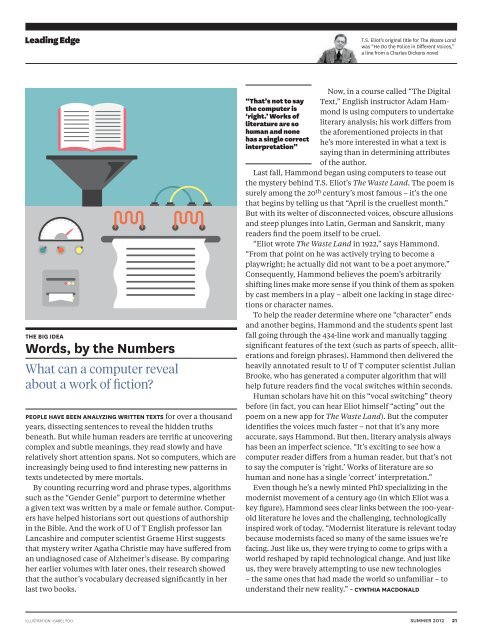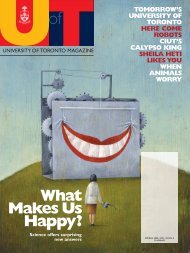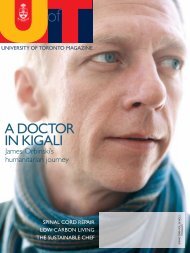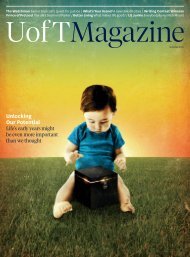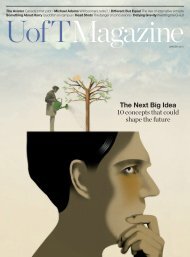What's the solution to Toronto's traffic problems? - University of ...
What's the solution to Toronto's traffic problems? - University of ...
What's the solution to Toronto's traffic problems? - University of ...
Create successful ePaper yourself
Turn your PDF publications into a flip-book with our unique Google optimized e-Paper software.
Leading Edge<br />
T.S. Eliot’s original title for The Waste Land<br />
was “He Do <strong>the</strong> Police in Different Voices,”<br />
a line from a Charles Dickens novel<br />
THE BIG IDEA<br />
Words, by <strong>the</strong> Numbers<br />
What can a computer reveal<br />
about a work <strong>of</strong> fiction<br />
PEOPLE HAVE BEEN ANALYZING WRITTEN TEXTS for over a thousand<br />
years, dissecting sentences <strong>to</strong> reveal <strong>the</strong> hidden truths<br />
beneath. But while human readers are terrific at uncovering<br />
complex and subtle meanings, <strong>the</strong>y read slowly and have<br />
relatively short attention spans. Not so computers, which are<br />
increasingly being used <strong>to</strong> find interesting new patterns in<br />
texts undetected by mere mortals.<br />
By counting recurring word and phrase types, algorithms<br />
such as <strong>the</strong> “Gender Genie” purport <strong>to</strong> determine whe<strong>the</strong>r<br />
a given text was written by a male or female author. Computers<br />
have helped his<strong>to</strong>rians sort out questions <strong>of</strong> authorship<br />
in <strong>the</strong> Bible. And <strong>the</strong> work <strong>of</strong> U <strong>of</strong> T English pr<strong>of</strong>essor Ian<br />
Lancashire and computer scientist Graeme Hirst suggests<br />
that mystery writer Agatha Christie may have suffered from<br />
an undiagnosed case <strong>of</strong> Alzheimer’s disease. By comparing<br />
her earlier volumes with later ones, <strong>the</strong>ir research showed<br />
that <strong>the</strong> author’s vocabulary decreased significantly in her<br />
last two books.<br />
Now, in a course called “The Digital<br />
“That’s not <strong>to</strong> say Text,” English instruc<strong>to</strong>r Adam Hammond<br />
is using computers <strong>to</strong> undertake<br />
<strong>the</strong> computer is<br />
‘right.’ Works <strong>of</strong><br />
literature are so literary analysis; his work differs from<br />
human and none <strong>the</strong> aforementioned projects in that<br />
has a single correct<br />
he’s more interested in what a text is<br />
interpretation”<br />
saying than in determining attributes<br />
<strong>of</strong> <strong>the</strong> author.<br />
Last fall, Hammond began using computers <strong>to</strong> tease out<br />
<strong>the</strong> mystery behind T.S. Eliot’s The Waste Land. The poem is<br />
surely among <strong>the</strong> 20 th century’s most famous – it’s <strong>the</strong> one<br />
that begins by telling us that “April is <strong>the</strong> cruellest month.”<br />
But with its welter <strong>of</strong> disconnected voices, obscure allusions<br />
and steep plunges in<strong>to</strong> Latin, German and Sanskrit, many<br />
readers find <strong>the</strong> poem itself <strong>to</strong> be cruel.<br />
“Eliot wrote The Waste Land in 1922,” says Hammond.<br />
“From that point on he was actively trying <strong>to</strong> become a<br />
playwright; he actually did not want <strong>to</strong> be a poet anymore.”<br />
Consequently, Hammond believes <strong>the</strong> poem’s arbitrarily<br />
shifting lines make more sense if you think <strong>of</strong> <strong>the</strong>m as spoken<br />
by cast members in a play – albeit one lacking in stage directions<br />
or character names.<br />
To help <strong>the</strong> reader determine where one “character” ends<br />
and ano<strong>the</strong>r begins, Hammond and <strong>the</strong> students spent last<br />
fall going through <strong>the</strong> 434-line work and manually tagging<br />
significant features <strong>of</strong> <strong>the</strong> text (such as parts <strong>of</strong> speech, alliterations<br />
and foreign phrases). Hammond <strong>the</strong>n delivered <strong>the</strong><br />
heavily annotated result <strong>to</strong> U <strong>of</strong> T computer scientist Julian<br />
Brooke, who has generated a computer algorithm that will<br />
help future readers find <strong>the</strong> vocal switches within seconds.<br />
Human scholars have hit on this “vocal switching” <strong>the</strong>ory<br />
before (in fact, you can hear Eliot himself “acting” out <strong>the</strong><br />
poem on a new app for The Waste Land). But <strong>the</strong> computer<br />
identifies <strong>the</strong> voices much faster – not that it’s any more<br />
accurate, says Hammond. But <strong>the</strong>n, literary analysis always<br />
has been an imperfect science. “It’s exciting <strong>to</strong> see how a<br />
computer reader differs from a human reader, but that’s not<br />
<strong>to</strong> say <strong>the</strong> computer is ‘right.’ Works <strong>of</strong> literature are so<br />
human and none has a single ‘correct’ interpretation.”<br />
Even though he’s a newly minted PhD specializing in <strong>the</strong><br />
modernist movement <strong>of</strong> a century ago (in which Eliot was a<br />
key figure), Hammond sees clear links between <strong>the</strong> 100-yearold<br />
literature he loves and <strong>the</strong> challenging, technologically<br />
inspired work <strong>of</strong> <strong>to</strong>day. “Modernist literature is relevant <strong>to</strong>day<br />
because modernists faced so many <strong>of</strong> <strong>the</strong> same issues we’re<br />
facing. Just like us, <strong>the</strong>y were trying <strong>to</strong> come <strong>to</strong> grips with a<br />
world reshaped by rapid technological change. And just like<br />
us, <strong>the</strong>y were bravely attempting <strong>to</strong> use new technologies<br />
– <strong>the</strong> same ones that had made <strong>the</strong> world so unfamiliar – <strong>to</strong><br />
understand <strong>the</strong>ir new reality.” – CYNTHIA MACDONALD<br />
ILLUSTRATION: ISABEL FOO<br />
summer 2012 21


